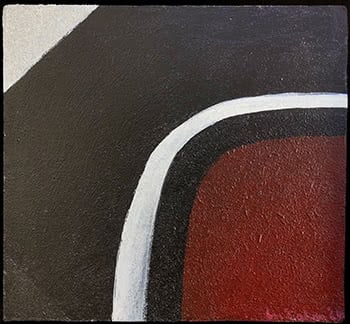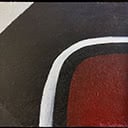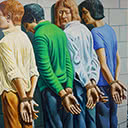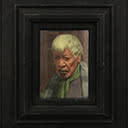Waterfall
22.2 x 24.5 cm
est. $40,000 - 60,000
PROVENANCE
Private Collection, Auckland
How many Waterfalls did McCahon paint? The McCahon website currently lists almost 100 and there are certainly others not previously recorded, including the present example. There were some precursors (one as early as 1956), and some as late as 1967, but the great majority of Waterfalls date from 1964, a watershed year for McCahon. He left his job at Auckland City Art Gallery after twelve years (1953- 64), and began his seven year stint teaching at Elam School of Fine Arts, 1964-71.
The first 44 Waterfalls were shown at Ikon Fine Arts, Lorne Street, Auckland in September 1964. Most of these were quite small in size (similar to the present example), though some larger works were also included, some as large as around a metre square. Because of the mainly small size many of the works shown were relatively inexpensive, many as low as 11 guineas (equivalent to around $2000 in today's dollars). This contributed to unusually large sales; in fact much to McCahon's surprise the show was almost a sell-out, his first commercial success. Previous to this McCahon's work had sold only to a handful of close friends and family. Waterfalls have remained among his most popular works ever since - some of the most recognisable and iconic of his images.
This particular Waterfall has a number of distinguishing features. First is colour: black, white and brick red. The red hillside in the lower right quarter, its profile echoing closely the curve of the white waterfall, is (in its colour) an unusual though not unique feature. The colour combination is similar to that of Maori design (as in kowhaiwhai rafter paintings) which was beginning to enter McCahon's painting at about this time. Second is texture: the rough, slightly grainy texture shows that McCahon has mixed either sawdust or sand with his oil paint. Third: corner off. This is one of relatively few Waterfalls which employ this device of cutting off one or more corners with a diagonal, creating a triangular patch of contrasting colour. One effect of this device is to move the work away from realism towards abstraction. Some identify the triangle in McCahon's work with the Trinity (Father, Son, and Holy Ghost) thus opening the possibility of a symbolic reading - the flow of redemptive water (or light) into a dark world.
However the meaning of the painting is interpreted, in execution it is beautifully balanced, coherent and resolved.





